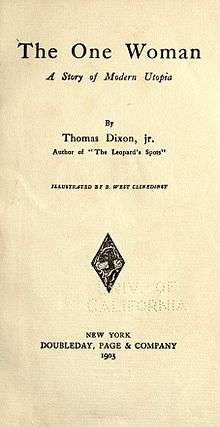The One Woman: A Story of Modern Utopia
 Title page of the first edition of The One Woman. | |
| Authors | Thomas Dixon, Jr. |
|---|---|
| Language | English |
| Publisher | Doubleday, Page[1] |
Publication date | 1903[1] |
| Pages | 350[1] |
The One Woman: A Story of Modern Utopia is a 1903 novel by Thomas Dixon, Jr..
Plot summary
Reverend Joseph Gordon, a preacher in New York City, clashes with church elders because of his socialist views.[2][3] Despite being a socialist, his best friend, Mark Overman, is a millionnaire Wall Street banker.[2]
Meanwhile, Gordon grows apart from his wife, Ruth, who disapproves of his politics.[2] After he starts a relationship with Kate Ransom, a wealthy female parishioner, he divorces his wife.[2] Kate Ransom donates a million dollars for him to start a new church and thus get rid of the disapproving church elders.[2][3] The new church is called called the "Temple of Man."[3]
Unfortunately, Kate Ransom falls in love with his friend Mark Overman.[2] The two men have a fight over the woman, and Gordon kills Overman.[2] Ransom tells the police about the murder and Gordon is sentenced to the death penalty.[2] Meanwhile, his faithful ex-wife asks her childhood lover, now the Governor of New York, to grant him a pardon, which he does.[2] Gordon is rescued from execution at the last minute.[2]
Main themes
The main theme is socialism.[2] Indeed, it has been described as an 'anti-socialist novel.'[4]
Another theme is feminism.[2][5] However, biographer Anthony Slide explains that it is construed as a by-product of socialism.[2]
Critical reception
The book was widely reviewed and became a best-seller.[2]
It has been interpreted as an attack on socialist clergyman George D. Herron, who had recently divorced.[6]
Theatrical and cinematic adaptations
The novel was adapted as a play in 1906.[4] The first performance took place in Norfolk, Virginia October of that year.[2][4] It was performed on a tour in the American South.[2] The main character, Frank Gordon, was played by D. W. Griffith.[4] His wife, Linda Arvidson, also acted in the play.[4] Two months later, they were replaced with cheaper actors.[4]
The novel was adapted into a film in 1918.[2][5] The screenwriters were Harry Chandlee and E. Richard Schayer.[2] It was directed by Reginald Barker.[2] It was shot in May–June 1918 at Paralta Studio on Melrose Avenue in Los Angeles.[2] Actors included W. Lawson Butt, Clara Williams and Adda Gleason.[2] The film, which is now lost, was reviewed in Variety.[2]
References
- 1 2 3 [http://catalog.hathitrust.org/Record/001375266?type[]=author&lookfor[]=%22Dixon%2C%20Thomas%2C%201864-1946.%22&ft= HathiTrust]
- 1 2 3 4 5 6 7 8 9 10 11 12 13 14 15 16 17 18 19 20 21 22 Anthony Slide, American Racist: The Life and Films of Thomas Dixon, Louisville, Kentucky: University Press of Kentucky, 2004, pp. 118-126
- 1 2 3 Edward J. Blum, W. Scott Poole, Vale of Tears: New Essays on Religion and Reconstruction, Macon, Georgia: Mercer University Press, 2005, p. 242
- 1 2 3 4 5 6 Melvyn Stokes, D.W. Griffith's the Birth of a Nation : A History of the Most Controversial Motion Picture of All Time: A History of the Most Controversial Motion Picture of All Time, Oxford, England: Oxford University Press, 2007, p. 52
- 1 2 Cary D. Wintz, 'Introduction', in Thomas Dixon, The Clansman: An Historical Romance of the Ku Klux Klan, M.E. Sharpe, 1941 , p. xv
- ↑ Ralph E. Luker, The Social Gospel in Black and White: American Racial Reform, 1885-1912, Chapel Hill, North Carolina: University of North Carolina Press, 1998, p. 293